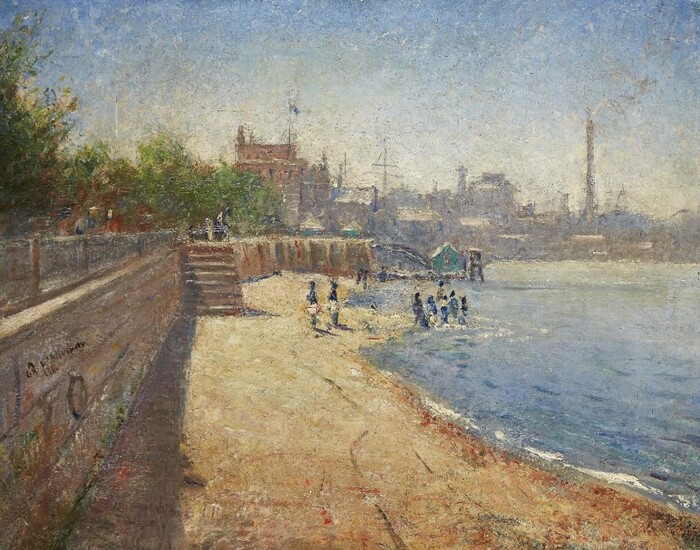Christopher Richard Wynne Nevinson ARA., British 1889-1946 - The Thames, 1911; oil on canvas, signed and dated left edge 'C. R. W. Nevinson. 1911', bears further inscriptions to the reverse, 40.5 x 50.7 cm Note: this rare and early example of...
Christopher Richard Wynne Nevinson ARA., British 1889-1946 - The Thames, 1911; oil on canvas, signed and dated left edge 'C. R. W. Nevinson. 1911', bears further inscriptions to the reverse, 40.5 x 50.7 cm
Note: this rare and early example of Nevinson's work was completed during his later years at the Slade School of Art. As a student at the prestigious art school from 1909-1912, Nevinson was part of a new wave of British Art studying alongside the likes of Stanley Spencer, Paul Nash, David Bomberg, William Roberts and Adrian Allinson, whilst building close friendships with Mark Gertler and Dora Carrington. During his period at the Slade, Nevinson's style was predominantly in the Impressionist format (noticeable in the present work), with close associations to the French Impressionists and Post Impressionists. He would even go on to attend the exhibition; 'Manet and the Post Impressionists' in 1910 with Charles Lewis-Hind and Gertler, contributing to the merging of French and English traditions in his future artworks. In his 1937 autobiography, he mentions that he often sketched in the Impressionist manner by the banks of the Thames while he was a student at the St John's Wood School of Art (1908-09), and had a tendency to pick London and Paris scenes, especially those involving water for his larger works. The present work seems to depict a view along Cheyne Walk & Chelsea Embankment. To the left there are iron railings which are still there today, above is the Old Anglican Church which was bombed during WWII. In the middle distance are buildings of the industrial area of Battersea, later replaced by the Power Station. Very few paintings of this period have been located, making this oil a unique example of the artist's early style. The composition closely resembles 'The Railway Bridge, Charenton', completed in the same year, now held at Manchester Art Gallery. The handling of the paint and impasto surface on both works are similar, capturing a fleeting moment along the banks of the river. Nevinson cleverly explores the play of light on moving water in the present work, whilst capturing an everyday scene from contemporary society, void of any specific narrative. Nevinson‚ style evidently changed in the years after his period at the Slade. By mid-1913 he had discovered Futurism which he remained closely associated with for the next few years. A large proportion of his most well known war art were executed in this style, and remains today a moving insight to the traumas of war. We are grateful to Dr. Jonathan Black for his assistance with the cataloguing of this work.
Please refer to department for condition report
View it on
Sale price
Estimate
Reserve
Time, Location
Auction House
Christopher Richard Wynne Nevinson ARA., British 1889-1946 - The Thames, 1911; oil on canvas, signed and dated left edge 'C. R. W. Nevinson. 1911', bears further inscriptions to the reverse, 40.5 x 50.7 cm
Note: this rare and early example of Nevinson's work was completed during his later years at the Slade School of Art. As a student at the prestigious art school from 1909-1912, Nevinson was part of a new wave of British Art studying alongside the likes of Stanley Spencer, Paul Nash, David Bomberg, William Roberts and Adrian Allinson, whilst building close friendships with Mark Gertler and Dora Carrington. During his period at the Slade, Nevinson's style was predominantly in the Impressionist format (noticeable in the present work), with close associations to the French Impressionists and Post Impressionists. He would even go on to attend the exhibition; 'Manet and the Post Impressionists' in 1910 with Charles Lewis-Hind and Gertler, contributing to the merging of French and English traditions in his future artworks. In his 1937 autobiography, he mentions that he often sketched in the Impressionist manner by the banks of the Thames while he was a student at the St John's Wood School of Art (1908-09), and had a tendency to pick London and Paris scenes, especially those involving water for his larger works. The present work seems to depict a view along Cheyne Walk & Chelsea Embankment. To the left there are iron railings which are still there today, above is the Old Anglican Church which was bombed during WWII. In the middle distance are buildings of the industrial area of Battersea, later replaced by the Power Station. Very few paintings of this period have been located, making this oil a unique example of the artist's early style. The composition closely resembles 'The Railway Bridge, Charenton', completed in the same year, now held at Manchester Art Gallery. The handling of the paint and impasto surface on both works are similar, capturing a fleeting moment along the banks of the river. Nevinson cleverly explores the play of light on moving water in the present work, whilst capturing an everyday scene from contemporary society, void of any specific narrative. Nevinson‚ style evidently changed in the years after his period at the Slade. By mid-1913 he had discovered Futurism which he remained closely associated with for the next few years. A large proportion of his most well known war art were executed in this style, and remains today a moving insight to the traumas of war. We are grateful to Dr. Jonathan Black for his assistance with the cataloguing of this work.
Please refer to department for condition report



